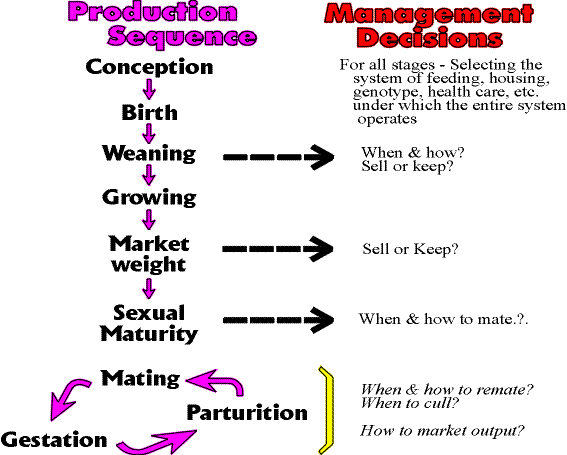
Primitive societies first domesticated animals as a convenient means of meeting immediate needs for food clothing and transport. Subsequently, for many thousands of years, livestock remained only one component of a regionally self sufficient and sustainable method to satisfy human demands. Even in the more developed countries, subsistence agriculture persisted until near the end of the nineteenth century. The pattern of family operated mixed farms, loosely organized into self contained rural communities and providing food for a number of small but growing urban centres, predominated until after the first world war throughout much of the world. Subsequently, mechanization and technological innovation produced substantial challenge, transition, change, consolidation and uncertainty. In many regions the surviving farms are now highly specialized, labour efficient, capital intensive and management demanding components of an integrated agri-food industry producing for both a regional and global market. Successful operation of any farm demands sound planning and astute decision making throughout all stages of the production sequence.

Agriculture will likely remain the most important source of human food and, although the outputs of convertible products and draft power will still be substantial, food production should continue as the major agricultural activity. Within the last few decades the concerns that fossil fuels may become depleted and the escalating costs for many inputs has focused attention on efficiency and agricultural activities are constantly being re-examined. Efficiency, usually expressed as the ratio of inputs to outputs, this can be calculated in biological or economic terms and often per unit of time.
Energy inputs and outputs per unit of land under various agricultural
production systems.
Points below the dotted line represent systems in which energy input
is greater than output. Note that animal systems are all low in comparison
with crop production or mixed farming.
Prepared from data calculated by Leach, 1975.
These ratios for energy inputs to outputs for many different farming systems around the world illustrate that livestock production systems are relatively inefficient in using support energy when compared with plant systems. They also show that subsistence farming practices and hunter-gathering lifestyles can be just as efficient as industrialised agriculture when evaluated on input/output ratios.
| Protein
(kg/ha/yr) |
Energy
(MJ/ha/yr) |
|
| Plant Products | ||
| Dry grass** | 1,100 | 180,000 |
| Cabbage | 1,100 | 33,500 |
| Corn | 430 | 83,700 |
| Wheat | 350 | 58,600 |
| Rice | 320 | 87,900 |
| Potatoes | 420 | 100,460 |
| Animal Products | ||
| Rabbits | 180 | 7,400 |
| Chickens | 92 | 4,600 |
| Lamb | 43 | 4,800 |
| Beef | 42 | 7,900 |
| Milk | 115 | 10,460 |
| **Not readily digestible by humans | Data from Spedding & Hoxey, 1975 | |
 Animal
production is a value added system which processes various inputs through
livestock with the expectation that outputs will be worth more than the
total input costs. Both natural factors and human interventions force domesticated
animals to live under conditions that may not always be ideal for production
or even for health. Since livestock exist, grow and reproduce within a
given set of physical and climatic factors, this animal-environmental relationship
suggests several possible strategies for production enhancement. Many livestock
improvement programmes commence with the introduction of "exotic" genotypes
with the potential for greater productivity. These often fail because the
necessary feed, disease prevention and environmental conditions required
for expression of the "exotic's" genetic potential cannot be provided.
Emphasis should be placed on improving feed resources, health care and
the physical conditions in which animals must exist in conjunction with
of even before adopting new genotypes.
Animal
production is a value added system which processes various inputs through
livestock with the expectation that outputs will be worth more than the
total input costs. Both natural factors and human interventions force domesticated
animals to live under conditions that may not always be ideal for production
or even for health. Since livestock exist, grow and reproduce within a
given set of physical and climatic factors, this animal-environmental relationship
suggests several possible strategies for production enhancement. Many livestock
improvement programmes commence with the introduction of "exotic" genotypes
with the potential for greater productivity. These often fail because the
necessary feed, disease prevention and environmental conditions required
for expression of the "exotic's" genetic potential cannot be provided.
Emphasis should be placed on improving feed resources, health care and
the physical conditions in which animals must exist in conjunction with
of even before adopting new genotypes.
The science of animal production has advanced to the state where knowledge exists on how to improve many of the components involved with performance. Unfortunately, for some of these procedures, the cost associated with providing the required inputs may exceed market value of the additional commodity produced. An additional challenge for producers, and for their professional advisors, is the initial and continuing evaluation of each new or existing technology to determine whether it should be cost effective when used on particular farms. Academics often propose "high tech" and therefore costly solutions for almost everything without appreciating the financial risks associated with farming. Fortunately, most farmers are usually much more conservative than their supporting R&D or extension officers.
Poor performance efficiency is often a symptom of some problem in the total production system. A holistic approach, considering all components and their interrelationships, is necessary to identify any underlying deficiencies and the weakest link in the sequence from conception to consumption. Once this comprehensive examination is completed any subsequent actions can focus on correcting the major problems rather than simply treating the symptoms.
Perhaps the most pressing challenges currently facing the global livestock industry are: